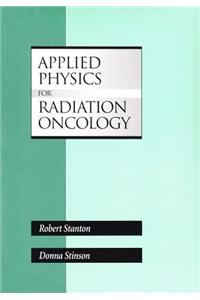
Applied Physics for Radiation Oncology
Author: Robert Stanton & Donna StinsonISBN: 9780944838600 ISBN10: 094483860X
Published: 1996 | 375 pp |
OUT OF PRINT
Medical Physics | March 1997
"This is an updated successor to 'An Introduction to Radiation Oncology Physics'
by the same authors (Medical Physics Publishing, 1992). Many students found
the earlier book to be much more accesible and readable than some of the
more advanced texts in the field. This book is intended for radiation therapists
George M. Uschold
and students of radiation therapy. Radiation oncology residents will also
benefit from it. Furthermore, it could also provide a quick overview for
non-therapy physicists who just wish to refresh their memory on the general
aspects of radiation therapy.
"This book is written with the objective to describe radiation therapy physics as it applies to the clinical practice. Both authors have many years of teaching and practical experience in radiotherapy. This is reflected by their didactic approach: logical sequence of the topics introduced, physical principles are explained in a simple and clear manner followed by worked examples and clinical practice. Those who have taught physics to either the technologists or residents will appreciate that it is a challenge to impart an understanding of physics relevant to clinical practice and at the same time trying to sustain their interest.
"The authors have tried to standardize the nomenclature for various quantities and factors. This will help reduce the confusion of terms and jargon used in radiation oncology. The book includes a new chapter on clinical applications to demonstrate the principles of treatment planning. Several recent clinical applications are described: mixed beams, non-coplanar beams in stereotactic radiosurgery and three-dimensional treatment planning.
"The coverage of quality assurance is rather thin. Since it is of great importance in the optimum delivery of radiation to the tumor, radiatshon therapists sould be trained to have a deep appreciation for it. I hope that it will receive greater emphasis in the next edition.
"One minor quibble is the incorrect use of the symbol for Kelvin; it should be written as K and not as 0K. This is a very common mistake, and physics teachers should take note and use correct physical quantities and symbols.
"The text introduces some minor confusion in Chapter 7 in the radiation protection quantities dose equivalent and equivalent dose, which are essentially identical. The newer equivalent dose is obtained by multiplying the dose by the radiation weighting factor, which is identical to the older quality factor, Q factor, used to obtain the dose equivalent.
"Overall, this book is highly recommendable. It has very high quality diagrams
which are simple yet powerful to illustrate underlying physics concepts.
The worked examples and the problem sets (with answers) are helpful to reinforce
the theory"
Kwan-Hoong Ng
University of Malaya, Milayasia


